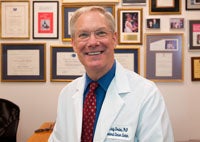V. Craig Jordan: The Conversation with Nature

Posted in GUMC Stories
 V. Craig Jordan, O.B.E., Ph.D., D.Sc., F.Med.Sci., who is scientific director and vice chairman of oncology at the Georgetown Lombardi Comprehensive Cancer Center, has been awarded the 2012 ASPET Goodman and Gillman Award in Drug Receptor Pharmacology, considered the most prestigious research award in the field of pharmacology. The American Society for Pharmacology and Experimental Therapeutics (ASPET) established this biennial award to recognize and stimulate outstanding research in the pharmacology of biological receptors. The inaugural winner of this award in 1980 was Georgetown University alumnus, Solomon H. Snyder, M.D., discoverer of the opiate receptor.
V. Craig Jordan, O.B.E., Ph.D., D.Sc., F.Med.Sci., who is scientific director and vice chairman of oncology at the Georgetown Lombardi Comprehensive Cancer Center, has been awarded the 2012 ASPET Goodman and Gillman Award in Drug Receptor Pharmacology, considered the most prestigious research award in the field of pharmacology. The American Society for Pharmacology and Experimental Therapeutics (ASPET) established this biennial award to recognize and stimulate outstanding research in the pharmacology of biological receptors. The inaugural winner of this award in 1980 was Georgetown University alumnus, Solomon H. Snyder, M.D., discoverer of the opiate receptor.
This year, Jordan is being honored for his seminal contributions in developing the pioneering breast cancer drug, tamoxifen.
Forty years ago, survival rates for breast cancer were comparatively grim. Jordan, then a visiting scientist at the Worcester Foundation for Experimental Biology in Massachusetts, began researching the idea that tamoxifen, a selective estrogen receptor modulator (SERM), could block estrogen receptors in breast tumors. Today, millions of women continue to live longer and healthier lives because of tamoxifen treatment.
Most breast cancers—over 70 percent—are estrogen positive, which means that the female hormone, estrogen, promotes the growth of the cancer cells. As with most targeted drugs for cancer, the long-term problem is resistance. Jordan set out to understand how to overcome tamoxifen resistance.
Because of Jordan’s continued research on SERMs [see Four Decades of Discovery in Breast Cancer Research and Treatment – an interview with V. Craig Jordan, by Marc Poirot], we now understand that these compounds act curiously both as estrogen inhibitors and estrogens, depending upon where they are distributed in the body. As a result, they are now commonly prescribed to treat other estrogenic disorders such as osteoporosis.
Describing his research philosophy, Jordan says, “Most of the things that I do, I call … ‘the conversation with nature.’ You ask questions of nature, and you get back the truth, because nature doesn’t know how to lie.”
How do breast cancer cells maintain their mutiny against the body, surviving a sustained antihormone attack that deprives them of their principal weapon for rapid growth? What is the mechanism and the timeframe for acquired tamoxifen resistance? He posed these questions to nature.
“You anticipate that when you expose breast cancer cells to estrogen they will grow,” he recounts. “After all, that’s the whole strategy for the treatment of breast cancer, using anti-estrogen, blocking estrogen action. However … one of my students (Doug Wolf) found that when you take cancer cells that have become resistant to anti-estrogen drugs and treat them with physiological estrogen, they end up dying very quickly. The tumors just melt away. It’s putting jet fuel into an old Volkswagen, and I want to know why that engine explodes.”
Suddenly, Jordan’s research team found itself in the middle of the “Haddow mystery.”
The first successful chemical therapy for any cancer was done in the 1940’s by British pathologist, Sir Alexander Haddow, who administered high-dose estrogen therapy to post-menopausal women with metastatic breast cancer. For women 20 years after their menopause, it was a remarkably effective treatment. Haddow said that his only regret was that he had no understanding of the underlying mechanism.
“My whole team is trying to decipher and document how estrogen is able to change from being a stimulator of growth of breast cancer, a bad player here, to actually being a killer of cancer cells,” Jordan says. “We are solving Haddow’s mystery.”
The unfolding answers appeared in Jordan’s inaugural article in the Proceedings of the National Academy of Sciences (PNAS) after his election as a member of the National Academy of Sciences in 2010. “My team is trying to put together a mosaic of answers of how estrogen does this, and if we can find out what nature is telling us, where this natural process is guiding us towards knowledge of mechanisms, maybe it will guide us toward a target we can apply to general cancers, and to a new group of drugs.”
By Frank Reider, GUMC Communications
